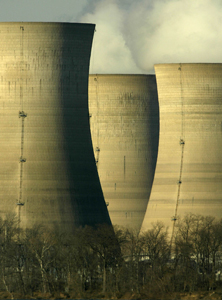By COOPER BROCK
 Following the recent tsunami-induced reactor meltdown in Japan, the nuclear energy debate has popped back into the public eye. The events in Japan, along with those at Chernobyl and Three Mile Island are all examples of what can happen if the United States continues to rely heavily on nuclear power. Therefore, nuclear power is far too dangerous to be viewed as a viable energy source for the future.
Following the recent tsunami-induced reactor meltdown in Japan, the nuclear energy debate has popped back into the public eye. The events in Japan, along with those at Chernobyl and Three Mile Island are all examples of what can happen if the United States continues to rely heavily on nuclear power. Therefore, nuclear power is far too dangerous to be viewed as a viable energy source for the future.
Nuclear power is obtained when enriched uranium is battered with neutrons, causing the uranium atoms to split, which releases heat. The heat is used to evaporate water into water vapor, which rises through vents and turns a large fan, producing electricity.
The reactor fuel, uranium, is found spread out among the earth’s crust. Nuclear power companies obtain it by strip mining, or blasting and excavating the uranium ore. The miners, who endure exposure to the radiation from airborne dust particles, are subject to higher risk of cancer. No profession should involve a drastically higher risk of cancer.
A nuclear power plant is not only dangerous to the lab workers who produce it, but it also can be potentially dangerous to those who live in the surrounding area. On April 26, 1986 the Chernobyl nuclear power plant in the former U.S.S.R. experienced a power surge, which caused a series of explosions, damaging the reactor. The reactor ignited and released a column of radioactive smoke into the air, which settled all around Russia and even in parts of eastern Europe.
In 2005, 19 years later, more than 6,000 cases of thyroid cancer were found in Russians who were in the surrounding area at the time. It has cost the Russian government the equivalent of 6.5 million American dollars to clean up the radiation. The United States cannot afford, in more ways than one, a disaster of this magnitude.
Along with the health of its inhabitants, nuclear power plants also puts the planet’s health in danger. Nuclear waste increases by 12,000 tons per year worldwide. The waste from a nuclear reactor has a half-life of 10,000 years. That means in 10,000 years, the radioactive waste will be halfway done cooling down. Twenty thousand years of radioactive waste should not be considered green.
No matter where the waste is sealed, it is still there, and it is still going to have to be dealt with when power companies run out of places to put it. The potential consequences of nuclear power drastically outweigh the benefits. There are multiple other options for energy, and the government, should be investing more money and time into those as we look to the future.